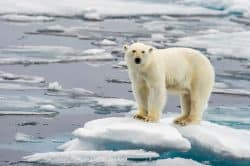Why it’s time to leave a linear economy behind and embrace something more circular…

‘No experience in my life could have given me a better understanding of the definition of the word “finite”. What we have out there is all we have; there is no more.’
Of course, she’s absolutely right. We are now all aware our planet is running out of many of the resources we rely heavily on, such as fresh water, coal and oil. Taking the latter as an example, as it stands, oil is estimated to run out by 2052. A mere 32 years away. And, yet, we all carry on using these finite resources as if they will last forever. We live in a take-make-waste world, whereby we take resources from the ground, make them into new products, and, once no longer needed, throw them away. Known as a linear economy, this system isn’t working – and, judging by the rising temperatures, shrinking ice sheets and extreme weather events, it feels like, perhaps, the planet is trying to tell us this.
So, if a linear economy doesn’t work, what do we need to have in place instead? Something a lot more circular…A circular economy is all about designing products that don’t create waste and pollution, keeping those products in use for as long as possible (and getting the maximum value out of them whilst in use), then recovering and regenerating them into new products. If we do this right, we should see less waste and less pressure on the environment, as well as greater resource productivity and innovation, increased competitiveness and economic growth. So, economically and environmentally, there are many benefits to this system.
To see a circular economy in action, let’s take a look at a few businesses already working in this way:
Philips – Light as a Service
Generally, when we need light, we buy light fittings and bulbs, use them until they run out, and then throw them away (take-make-waste). Philips have designed a service, where customers can simply pay for the light they use. So, instead of buying the light fittings and bulbs, customers are buying the light. In this sense, light becomes a service. Philips keep ownership of the fittings throughout, so are incentivised to design long-lasting fittings that are easy to repair, and customers save on potential maintenance costs. The whole model is about giving customers the right light for their needs, only using as much energy as is required and avoiding waste or surplus.
Ecovative – An alternative to polystyrene
Single-use plastics are now well-known for their damaging effect on the environment. And expanded polystyrene, used heavily in packaging, is no exception to this. So Ecovative set to work finding an alternative that had the same protective qualities and similar cost, without the environmental issues on top. Their solution? Packaging products made from the roots of mushrooms (mycelium). Grown amongst agricultural bi-product (that acts a bit like glue), the mycelium digests the bi-product and is able to bind into any shape needed in just 5-7 days. And, after use, the mycelium packaging can be composted at home.
Hiut Denim – Free repairs for life
These days, we live in a world of “fast fashion”, buying clothes on a frequent basis, all year round. Unfortunately, to keep up with this pace, these clothes are sometimes made using cheap materials and labour, and environmental corners are cut in the name of profit. On top of this, consumers are disposing of these clothes quickly, often under a year of buying them. Hiut Demin have devised a strategy to avoid this happening with the clothes they make. In the first place, they design their jeans in a way that ensures they are built to last, but they also offer customers free repairs, meaning their jeans can keep on being used for years to come.
These are just three of many brilliant examples of businesses transitioning to a circular economy. But we need more. As individuals, businesses and organisations, we have to take responsibility and stop feeding into the linear economy and take-make-waste culture. It’s time to become a whole lot more circular. At Printwaste, this is at the heart of what we do. To us, your waste is always a potential resource, never something to be dumped in landfill. And, even after all these years of working with waste, we still get excited about what it can be turned into. Want to find out? Visit our website, give us a call on 01242 588600 or email us at info@printwaste.co.uk.

